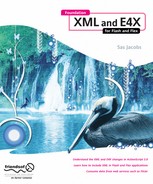Book Description
XML is the lingua franca of the Web. All designers and developers working in a web environment need a sound understanding of XML and its role in application development. Many software packages and organizations allow for the exchange of data using an XML format. Web services and RSS feeds are now commonplace.
For those working with Flash and Flex, a thorough understanding of XML is particularly important. XML documents are one option for the data provided to SWF applications. Flash and Flex can load, display, and modify XML content. These applications can also send XML content to other applications for updating or for use in different situations.
ActionScript 3.0 introduced some fundamental changes to the way in which Flash and Flex applications work with XML. One significant change is that XML is now a native data type. ActionScript 3.0 also introduced new classes and a different framework for working with external documents. These changes are based on the E4X ECMAScript standard, and they streamline and simplify the process for working with XML in Flash and Flex.
In Foundation XML and E4X for Flash and Flex, Sas Jacobs gives you an introduction to XML and E4X. She explores the XML and XMLList classes and explains E4X expressions, providing examples for both Flash and Flex. In addition to explaining how to incorporate XML documents in Shockwave Flash applications, Sas shows you approaches specific to Flash and Flex and explores real-world usage. The book finishes with two case studies. In the first, you will learn how to consume and display information and images from Flickr using Flash. In the second, you will work with Adobe Kuler in Flex.
Whether you are a designer or developer, this book will help you work with XML and make the transition from ActionScript 2.0 to ActionScript 3.0. It will also provide you with an excellent grounding if you are new to Flash and Flex.
Table of Contents
- Copyright
- ABOUT THE AUTHOR
- ABOUT THE TECHNICAL REVIEWER
- ABOUT THE COVER IMAGE DESIGNER
- ACKNOWLEDGMENTS
- INTRODUCTION
- 1. INTRODUCTION TO XML
- 2. GENERATING XML CONTENT
- 2.1. Authoring XML documents in a text editor
- 2.2. Generating XML content from a database
- 2.3. Generating XML from other software packages
- 2.4. Validation and XML content in SWF applications
- 2.5. Summary
- 3. ACTIONSCRIPT 3.0 AND XML
- 3.1. Differences between ActionScript 2.0 and 3.0
- 3.2. XML as an ActionScript data type
- 3.3. Overview of the new ActionScript 3.0 classes
- 3.4. Working with the XML class
- 3.5. Working with the XMLList class
- 3.6. Working with the XMLListCollection class in Flex
- 3.7. Understanding the Namespace class
- 3.8. Understanding the QName class
- 3.9. Limitations of working with the XML class
- 3.10. Summary
- 4. USING E4X EXPRESSIONS
- 4.1. Understanding E4X expressions
- 4.2. Working with filter expressions
- 4.3. Assigning values
- 4.4. Deleting content
- 4.5. E4X in action
- 4.6. Summary
- 5. USING THE URLLOADER CLASS WITH XML DOCUMENTS
- 6. LOADING METHODS SPECIFIC TO FLEX
- 6.1. Loading external content
- 6.2. Using the <mx:HTTPService> tag
- 6.3. Using the HTTPService class
- 6.4. Accessing loaded content
- 6.5. Working through an <mx:HTTPService> tag example
- 6.6. Working through an HTTPService class example
- 6.7. Passing variables with the request
- 6.8. Summary
- 7. LOADING METHODS SPECIFIC TO FLASH
- 8. MODIFYING XML CONTENT WITH ACTIONSCRIPT 3.0
- 9. COMMUNICATING WITH THE SERVER
- 9.1. Sending data to the server
- 9.2. Working with the URLLoader class
- 9.3. Sending variables with the <mx:HTTPService> element
- 9.4. Working with the HTTPService class in Flex
- 9.5. Choosing the Flex approach
- 9.6. Summary
- 10. CONSUMING WEB SERVICES WITH FLEX
- 11. CONSUMING WEB SERVICES WITH FLASH
- 11.1. Consuming web services with the URLLoader class
- 11.2. Consuming a SOAP web service with the WebServiceConnector component
- 11.3. Summary
- 12. FLASH CASE STUDY
- 12.1. Understanding Flickr
- 12.2. Building the application
- 12.2.1. Working through the interface
- 12.2.2. Setting up the application
- 12.2.3. Getting the recent photos list
- 12.2.4. Displaying a large image and title
- 12.2.5. Adding paging functionality
- 12.2.6. Making cosmetic changes to the interface
- 12.2.7. Viewing interesting photos
- 12.2.8. Searching Flickr
- 12.2.9. Showing owner information
- 12.3. Summary
- 13. FLEX CASE STUDY
- 13.1. Understanding Adobe Kuler
- 13.2. Building the application
- 13.2.1. Working through the interface
- 13.2.2. Setting up the application
- 13.2.3. Creating the custom class file
- 13.2.4. Getting the highest rated themes
- 13.2.5. Displaying the theme
- 13.2.6. Adding paging functionality
- 13.2.7. Displaying the most popular schemes
- 13.2.8. Searching Kuler
- 13.2.9. Reviewing the completed code
- 13.3. Summary
